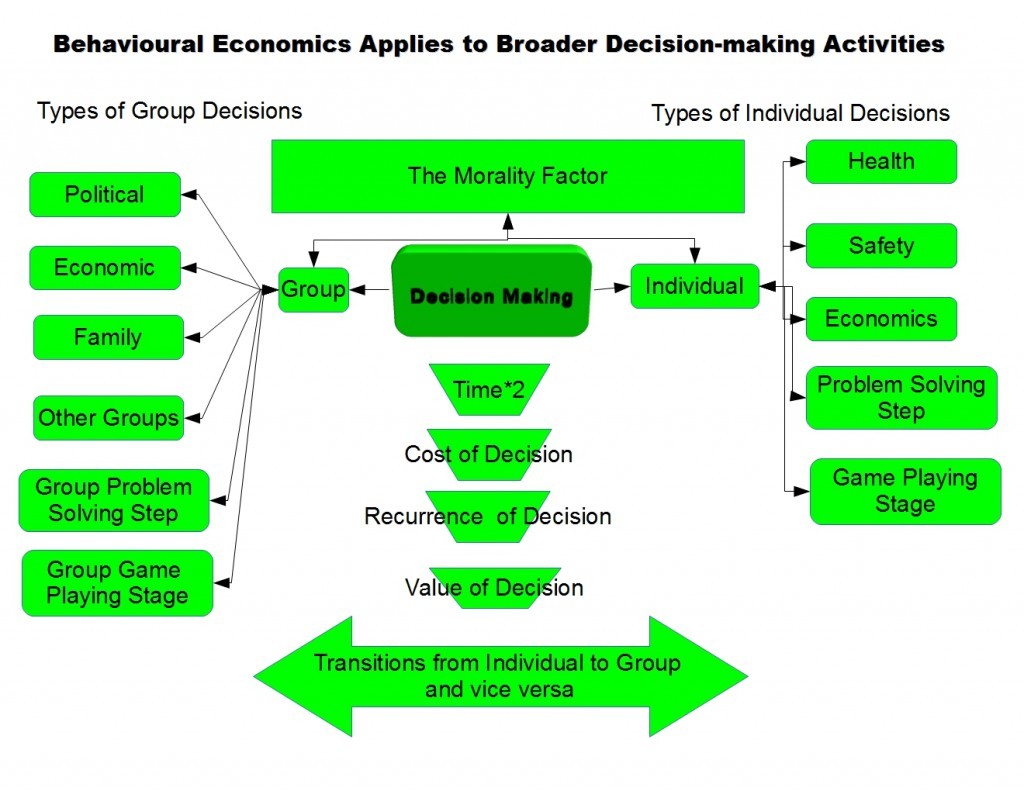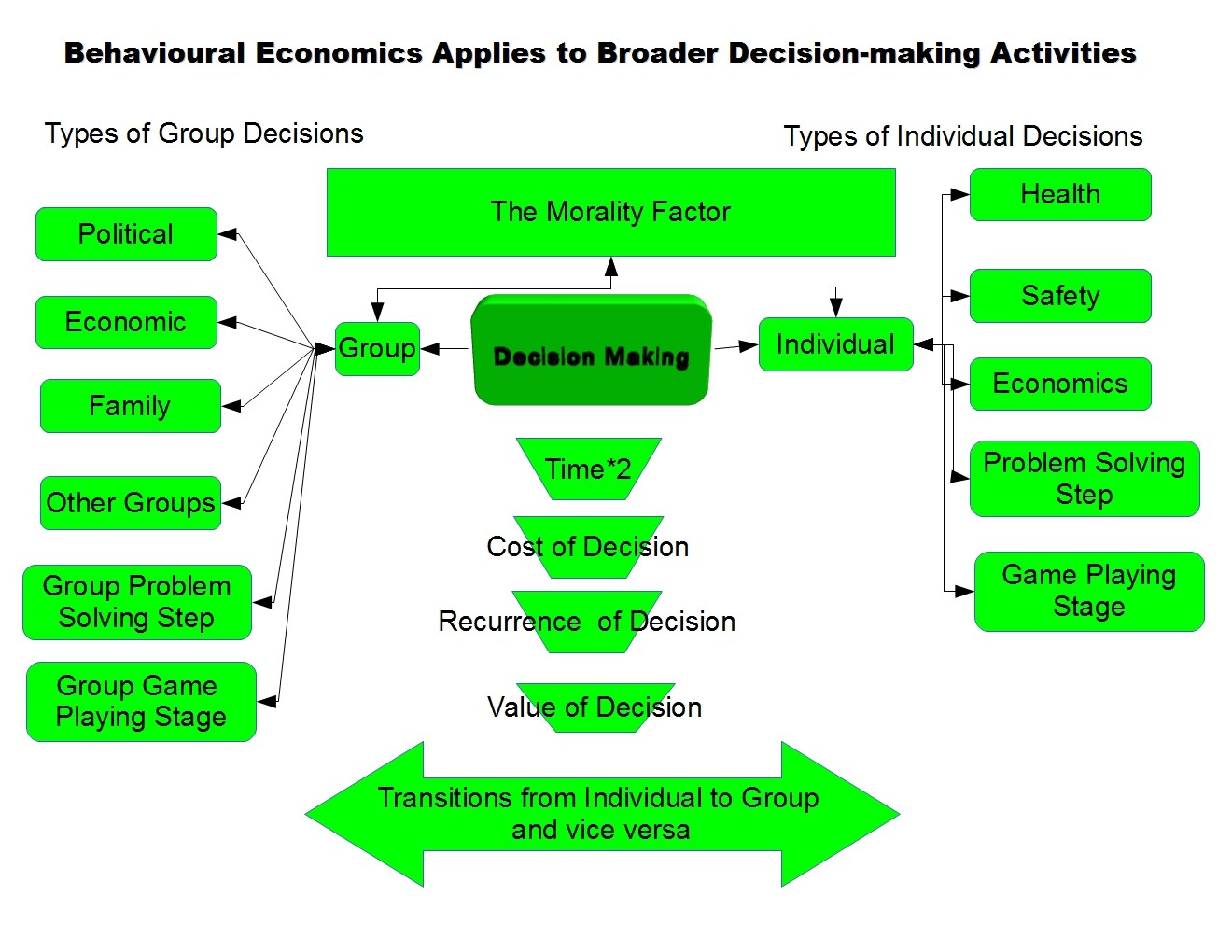In the Coursera class Behavioral Economics taught by Duke Professor Dan Ariely, all the students had to write a mid-term essay in which they described the ideas of Behavioral Economics and how the methods of the discipline could be used to solve an economic problem. Despite the fact, that most of the methods in the class to date applied to individual economic decision making, the methods appeared to be robust enough to be applied to social and political problems. So my essay would try to do 3 things – 1)summarize the general outlines of Behaviorial Economics, 2)highlight areas where social and political processes were influenced by Behaviorial Economics and 3)then apply those methods to a social problem.
The Problem: Voter Ignorance and Apathy in National Elections
Behaviorial Economics and Irrational Behavior are departures from the standard Utility and Preferences theory of both decision making and economic choice. Each discipline relies on utility theory and remembered/internalized preferences as being the drivers of behavior. But this course has shown how many departures from the standard utility model can be shown to occur almost unconsciously yet consistently across ages, national boundaries, gender and social groups. In short, Behavioral Economics describes the conditions when individuals and small groups depart from the classic rational model of economic choice and start to consistently exhibit “irrational” behaviors such as loss aversion, pain of payment, and relative anchoring versus the expected absolute valuation among other departures from the rational.
Kahneman and Tversky – established fast and slow decision making with startlingly different mental models and neural pathways. See the paper at bit.ly/u9nNZ2. System 1 is fast and can be shown to link the limbic or primitive automatic brain structures to fast, instinctive decisions. System 1 is intuitive, rapid, and designed for situations where gut feeling or intuitive quick response is required [think fight or flight, honest emotional response, etc]. System 2 is slower, deliberate and is used to analyze, examine and vet more closely System 1 responses. System 2 can be mapped to the cortex and frontal lobes of humans and comprises the new brain functions. People take all sorts of shortcuts and conscious/unconscious irrational behaviors to cope with the flood and complexity of decisions throughout daily life switching between System 1 vs System 2 responses as time, costs, and previous decision success dictate.
Camerer – describes the above and other work as “behavioral economics represents a reunification of psychology and economics, rather than a brand new synthesis, because early thinking about economics was shot through with psychological insight” and goes on to provide 4 models of how economics can be modified by insights on the psychology of not-always rational behavior. See this overview paper at bit.ly/13XTTRf
Kenrick et alia – describe Deep Rationality as being based on evolutionary roots which show decision making modes with strong evolutionary fitness components – so Economics+Psychology+Evolution of Behavior Rules are seen as tightly linked – see this novel view at 1.usa.gov/14kpkEK
Sunstein – shows how the behaviorial economics of Choice Architectures has influenced government policymaking.The dramatic difference between Opt-out vs Opt-in organ donor cards illustrates the power choice architecture has on decisions – see major ideas and references at bit.ly/TExfUz
So this course has moved from bounded rationality in individual economic decision making, the traditional domain of Behaviorial Economics, to the examination of irrationality in group/political decision making. The chart below tracks this broader scope:
Note the group or social element and how decisions in either domain transition between group and individual
Professoor Ariely has shown how many individual decision situations are influenced by group or social factors. Salient examples are the social vs market/money norms on gifts or free work . Another is the role of social proof in the constant low-level of dishonesty which appears to bypass Becker’s Benefits versus Cost of Being Caught analysis. Thus, the week 3 lectures and readings on Dishonesty a)clearly plunked the course into social/group norms and b)provided surprising results on how cheating is influenced by group and social factors.
Clearly decisions about social morality and norms are at the crux of the matter in many current events. For example, Too Big To Fail and Too Big To Jail Wall Street Malfeasance – bit.ly/XXmscU ,Boston Marathon Bombers Radicalization, and the foundering of Gun Background Checks in Congress – bit.ly/XYD8TE. All of the phenomenon have great dollops of Irrational Behaviors in a social as well as individual decision making context. So how can we hope to address the Politics of Voting Behavior using Behaviorial Economics when the scope is so vast?
The Political Problem
At the same time as this course I am taking Coursera’s Democratic Development which agrees with the Economist’s Democracy Index – bit.ly/Xpd4vb that identifies free and fair elections based on an active and informed electorate as a pillar of effective democratic government. The problem is that voter participation rates can be very low in the World and the US especially. Voter turnout for the Presidential elections have seen an uptick from 1988’s historical low of 49.0% to 57.1% in 2008 and then 57.9% in 2008 and 2012. – bit.ly/oVYJdG. The quality of a Democracy is in direct proportion to the informed state and willingness to vote of the electorate. Unfortunately, in many Democracies including the US, the famous line of Walt Kelly’s Pogo applies – “We have met the enemy and They is US”.
And if one looks at the classical model for voting, P*B+D > C where P=probability vote will count for the favored candidate winning, B=the benefits derived from the candidate winning, D= derived gratification from voting, C=Cost in time, effort, and financial expenses to vote, there is ample room for irrational factors to come into play. In fact the consensus is that adding incentives to vote are a)illegal and b)hardly guarantee an informed vote.bit.ly/12J1wIu But on helping people become more informed, the view is surprisingly more positive. Shineman argues if you mobilize them they become more informed – bit.ly/XXPwRN Knight Foundation has a contest devoted to the challenge of informing voters in in an unbiased fashion on key issues- there are 40 innovative policies kng.ht/12DU9Vk. So the problem of getting out the vote and having an informed electorate seems approachable. But lets step back and get an overview of elections.
Elections 101
Since the Supreme Court’s Citizen United decision in 2010 removed many of the Watergate and other restrictions on campaign financing, the 2010 and 2012 elections have grown dramatically in campaign spending. For example, the 2012Federal election is estimated to have cost $6billion compared to $5.2 billion in 2008, a 15% growth rate. But the 2012 federal campaign spending figure may be too low due to changes in the tax code and federal reporting requirements. In the States, campaign spending for 2012 amounted to $2.6B. Estimates for total 2012 federal, state and local campaign spending Certainly elections are a multi-billion and growing industry.
So inevitably this amount of spending has attracted a lot of attention and some interesting approaches on how to run a campaign. Catherine Shaw’s The Campaign Manager
is a highly-rated book describing the latest campaign strategies and policies with a specific eye to local elections. This is an electoral how to manual. In contrast,Green and Gerber’s Get Out the Vote: How to Increase Voter Turnout recommends a more disciplined and experimental approach that attempts to measure what various campaign policies cost versus the number of voters they turnout. They use Behavioral Economic methods and then test all campaign strategies by seeing what happens in the different sections of an electoral district in which carefully controlled tests of campaign methods are used. In short, Green and Gerber are trying to establish tested measures of campaign effectiveness. Given the billions of dollars being spent in elections, this new vigor inspired by Social Psychology and Behavioral Economics is long overdue.Another recent book,The Behavioral Foundations of Public Policy
, examines how the Social Sciences are beginning to have a profound effect on Public PolicyMaking. There are a number of areas where the Behaviorial Economics have been applied and these policies echo the notable work of Cass Sunstein’s Simpler strategy for better government in which techniques such as Defaults Options, Choice Architecture, and choice simplification have been used to substantially change how the federal government deals with the public over the past four years. Significantly, the Behavioural Foundation’s book underlines how Behavioral Economics guest lecturer Todd Rogers has been able to enhance voter turnout dramatically in election campaigns.This is significant because despite the huge amount of moneys spent on election campaigns, the campaign teams only knew by anecdotal references how effective their mobilization techniques might be. Todd points out how in the last 3 major elections a shift has taken place towards using Behavioral Economics methods. The classic rational voter model of mobilization is supplemented by adding to the call or leaflet scripts 1) plan making nudges, 2)immediate identity as being a voter, 3)social herding by referencing how big a turnout is expected. But the most effective technique depended on simple social pressure . Adding an innocent accountability note “We may call you post election to find out about your voting experience” added to the script increased mobilization effectiveness by as much as 40%. Clearly new, small behavioral nudges are having major impacts on elections. Hopefully, studies on what methods are truly effective in election campaigns will help clear out the current tsunami of attack ads.
Summary
What became evident from the the above readings and books, is that methods derived from Behavioral Economics are indeed being used in addressing both voter ignorance and apathy in federal elections. The success of the methods has been largely positive in voter mobilization and helpful in addressing voter awareness of critical issues. More broadly, Behavioral Economics and Social Psychology are just now being used to address the issues of making the federal government and its myriad of regulations simpler and more effective for the public
PostScript
As you can see, my essay ballooned up to nearly double the legal limit of 805 words in the class exercise. But in my defense, I would point to the various required and suggested readings in the course and point out their length put my scrawny offering to shame lengthwise but hopefully not information or utility wise.
Speaking of readings, one can see with the essay’s numerous book references, that Dan precipitated a mini-gold rush for Amazon.com. So in that spirit let me list my 5 favorite books and/or readings for the course:
Kahneman – Thinking Fast and Slow is a very readable exploration of Kahneman’s Nobel Prize winning research into modes of thinking. This is the foundation for much of Behavioral Economics.
Wikipedia – the list of cognitive biases with references. Because it is wikipedia should not mean it is taboo. This is a great starting point and reference check.
Sunstein – Simpler: The Future of Government shows how Behavioral Economic principles are being used now to make government simpler and more effective. This book disproves the notion that governance can only be made better by making it smaller or cutting it out altogether.
Dan Ariely
Cialdini – Influence: Science and Practice is another advocate of testing methods of persuaion and influence which show the social side of bounded rationality.


